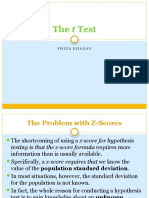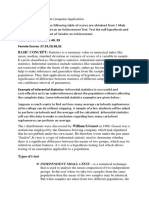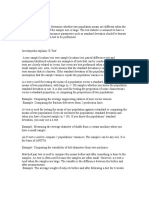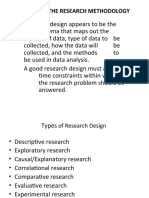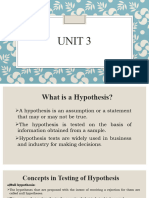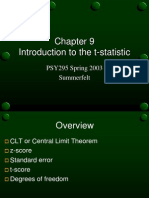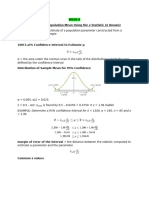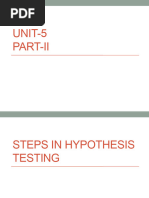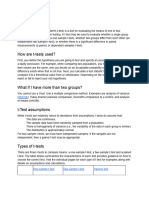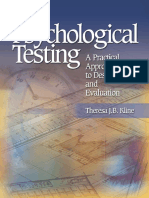Assignment 1 Research Methodology
Uploaded by
becbellaryAssignment 1 Research Methodology
Uploaded by
becbellaryAssignment 1 Research methodology
Submitted to Prof. S G Patil Department of Business Administration Rani Channamma University Belagavi
Submitted by MohammedJaved Kalburgi Research scholar
Single Group Z and T-Tests
The basic goal of these simple tests is to show that the distributions of the given data under examination are not produced by chance and that there is some systematic pattern therein. Main point is to show the mean of a sample is reflective of the population. Salkinds text skips a discussion of single group/sample T-Tests. Recall that a Z-score can measure the location of a given value on a normal distribution, which can be expressed as a probability. A Z-Test uses the normal distribution to obtain a test statistic based on some data that can be compared with a sampling distribution of chance, which is an abstract construction drawn from the data. This is parameter estimation, which is an inference of a sample based on a population of data. But because we do not often know the population variance, 2, we estimate a single point estimate or value (sample mean). However, this sample mean may vary greatly from the real population mean, . This error is called sampling error. A confidence interval is set up to estimate . This is a range of values that is likely to include the value of the population mean (at the center of the interval). The larger the sample, the more the sample mean should equal the population mean, but there may be some error within the confidence interval. How far is the from ?
Students T-Test
Problem: We may not know the mean and variance of some populations, which means we cannot do a Z-Test. In this case, we use a T-test, Students T to be specific, for use with a single group or sample of data. Again, this is when we are not looking at different groups but a sample of data as an entirety. We will next examine differences in groups.
One uses this test when the population variance is unknown, as is usually the case in the social sciences. The standard error of the sampling distribution of the sample mean is estimated. A t distribution (not normal curve, more platykurtic but mean=0) is used to create confidence intervals, like critical values. Very similar to the Z distribution by assuming normality. Normality is obtained after about 100 data observations. Basic rule of parameter estimation: the higher the obs (N) of sample the more reflective of overall population.
The t formula
y y Sy N 1
CI Y t / 2 (S y / N 1)
For =.05 and N=30 , t =2.045
T-Tests of Independence
Used to test whether there is a significant difference between the means of two samples. We are testing for independence, meaning the two samples are related or not. This is a one-time test, not over time with multiple observations. Useful in experiments where people are assigned to two groups, when there should be no differences, and then introduce Independent variables (treatment) to see if groups have real differences, which would be attributable to introduced X variable. This implies the samples are from different populations (with different ).
This is the Completely Randomized Two-Group Design. For example, we can take a random set of independent voters who have not made up their minds about who to vote for in the 2004 election. But we have another suspicion: H1: watching campaign commercials increases consumption of Twinkies (snackie cakes), or 1 2 Null is 1= 2
After one group watches the commercials, but not the other, we measure Twinkie in-take. We find that indeed the group exposed to political commercials indeed ate more Twinkies. We thus conclude that political advertising leads to obesity.
Nonparametric Test of Chi2 Used when too many assumptions are violated in T-Tests: Sample size to small to reflect population Data are not continuous and thus appropriate for parametric tests based on normal distributions. Chi2 is another way of showing that some pattern in data is not created randomly by chance. Chi2 can be one or two dimensional. Again, the basic question is what you are observing in some given data created by chance or through some systematic process?
(O E ) 2 E O observedfrequency
E exp ectedfrequecy
The null hypothesis we are testing here is that the proportion of occurrences in each category are equal to each other. Our research hypothesis is that they are not equal. Given the sample size, how many cases could we expect in each category (n/#categories)? The obtained/critical value estimation will provide a coefficient and a Pr. that the results are random.
You might also like
- 3 - Data Analysis - Tests of DifferencesNo ratings yet3 - Data Analysis - Tests of Differences50 pages
- Test On Variables: in Surveys, The Foolish Ask Questions, Wise Cannot AnswersNo ratings yetTest On Variables: in Surveys, The Foolish Ask Questions, Wise Cannot Answers24 pages
- "T" Test: DR - Shovan Padhy DM1 Yr (Senior Resident) Dept. of CP & T NIMS, HyderabadNo ratings yet"T" Test: DR - Shovan Padhy DM1 Yr (Senior Resident) Dept. of CP & T NIMS, Hyderabad20 pages
- Course Unit 6 - Introduction To Statistical Inference - T Test and Z TestNo ratings yetCourse Unit 6 - Introduction To Statistical Inference - T Test and Z Test6 pages
- Business Analytics & Machine Learning: Regression AnalysisNo ratings yetBusiness Analytics & Machine Learning: Regression Analysis58 pages
- Chapter - 9 - Introduction To The T StatisticNo ratings yetChapter - 9 - Introduction To The T Statistic41 pages
- Hypothesis Testing For Two Sample MeansNo ratings yetHypothesis Testing For Two Sample Means17 pages
- Research Methods: Inferential Statistics: Two Group DesignNo ratings yetResearch Methods: Inferential Statistics: Two Group Design36 pages
- Hypothesis Testing: Two Populations: Learning ObjectivesNo ratings yetHypothesis Testing: Two Populations: Learning Objectives23 pages
- T Testparametrictest 240312054518 6094c5a0No ratings yetT Testparametrictest 240312054518 6094c5a09 pages
- Introduction To The T-Statistic: PSY295 Spring 2003 SummerfeltNo ratings yetIntroduction To The T-Statistic: PSY295 Spring 2003 Summerfelt19 pages
- Wk. 13 Ppt. - Quantitative Techniques in BusinessNo ratings yetWk. 13 Ppt. - Quantitative Techniques in Business24 pages
- 4.02 Comparing Group Means - T-Tests and One-Way ANOVA Using Stata, SAS, R, and SPSS (2009)No ratings yet4.02 Comparing Group Means - T-Tests and One-Way ANOVA Using Stata, SAS, R, and SPSS (2009)51 pages
- Hypothesis Testing Parametric and Non Parametric TestsNo ratings yetHypothesis Testing Parametric and Non Parametric Tests14 pages
- Analysing and Presenting Data: Practical Hints: Daniele CEI, Giorgio MATTEINo ratings yetAnalysing and Presenting Data: Practical Hints: Daniele CEI, Giorgio MATTEI53 pages
- Inferential Statistics For Print Part INo ratings yetInferential Statistics For Print Part I23 pages
- Huypothesis Testing Final Notes 2020 - 2021No ratings yetHuypothesis Testing Final Notes 2020 - 202133 pages
- Hypothesis Testing : Z-Test, T-Test, F-TestNo ratings yetHypothesis Testing : Z-Test, T-Test, F-Test42 pages
- Reskilling of Employees More Important To IT Industry - NASSCOM - The Economic TimesNo ratings yetReskilling of Employees More Important To IT Industry - NASSCOM - The Economic Times2 pages
- A Study On The Factors Affecting Employee Retention-91No ratings yetA Study On The Factors Affecting Employee Retention-915 pages
- Business Research Methods: Iv - Semester Bba Bangalore University100% (1)Business Research Methods: Iv - Semester Bba Bangalore University89 pages
- Reference Checking & Appointment OrdersNo ratings yetReference Checking & Appointment Orders12 pages
- A Study On The Factors Affecting Employee Retention-91No ratings yetA Study On The Factors Affecting Employee Retention-915 pages
- Human Resource Management: Job AnalysisNo ratings yetHuman Resource Management: Job Analysis53 pages
- Chapter-2: Growth and Prospects of Chemical Industry in GujaratNo ratings yetChapter-2: Growth and Prospects of Chemical Industry in Gujarat57 pages
- Designing Performance Measurement System With Balanced Scorecard (Case Study of Abc, A Bogor City Regional-Owned Company)No ratings yetDesigning Performance Measurement System With Balanced Scorecard (Case Study of Abc, A Bogor City Regional-Owned Company)11 pages
- Royal Commission On Systems of Election (1910)100% (1)Royal Commission On Systems of Election (1910)84 pages
- Lesson Plan Practical Research 2 Quantitative ResearchNo ratings yetLesson Plan Practical Research 2 Quantitative Research3 pages
- Division of Southern Leyte Sta. Paz National High School Pasanon, San Francisco, Southern Leyte Mean Percentile With Number of Students and Raw Score Statistics and Probability - Third QuarterNo ratings yetDivision of Southern Leyte Sta. Paz National High School Pasanon, San Francisco, Southern Leyte Mean Percentile With Number of Students and Raw Score Statistics and Probability - Third Quarter4 pages
- canossa_s3_maths_final exam_paper 2_15-16No ratings yetcanossa_s3_maths_final exam_paper 2_15-1612 pages
- A Beginners Guide To Hypothesis Testing - Hypothesis Made Simple - Data Dojo - Data Analytics With Sunil KappalNo ratings yetA Beginners Guide To Hypothesis Testing - Hypothesis Made Simple - Data Dojo - Data Analytics With Sunil Kappal5 pages
- UGC NET Previous Year Question Paper History 2023 1No ratings yetUGC NET Previous Year Question Paper History 2023 193 pages
- QNT 561 Final Exam - QNT 561 Week 1 Practice Quiz 45 Questions - UOP StudentsNo ratings yetQNT 561 Final Exam - QNT 561 Week 1 Practice Quiz 45 Questions - UOP Students36 pages
- Stratified Cluster Sampling: BMJ (Online) November 2013No ratings yetStratified Cluster Sampling: BMJ (Online) November 20133 pages
- NRT2001 2007ReadingMathStatewideComparisonNo ratings yetNRT2001 2007ReadingMathStatewideComparison2 pages
- RRB ALP Mechanic Radio TV 23 Jan 2019 Official Paper Shift 3 English 5c9e244a81d4f19b74afc70cd05495deNo ratings yetRRB ALP Mechanic Radio TV 23 Jan 2019 Official Paper Shift 3 English 5c9e244a81d4f19b74afc70cd05495de55 pages
- The True Experiment - Anushka Kashyap (BA019008)No ratings yetThe True Experiment - Anushka Kashyap (BA019008)3 pages
- Test On Variables: in Surveys, The Foolish Ask Questions, Wise Cannot AnswersTest On Variables: in Surveys, The Foolish Ask Questions, Wise Cannot Answers
- "T" Test: DR - Shovan Padhy DM1 Yr (Senior Resident) Dept. of CP & T NIMS, Hyderabad"T" Test: DR - Shovan Padhy DM1 Yr (Senior Resident) Dept. of CP & T NIMS, Hyderabad
- Course Unit 6 - Introduction To Statistical Inference - T Test and Z TestCourse Unit 6 - Introduction To Statistical Inference - T Test and Z Test
- Business Analytics & Machine Learning: Regression AnalysisBusiness Analytics & Machine Learning: Regression Analysis
- Research Methods: Inferential Statistics: Two Group DesignResearch Methods: Inferential Statistics: Two Group Design
- Hypothesis Testing: Two Populations: Learning ObjectivesHypothesis Testing: Two Populations: Learning Objectives
- Introduction To The T-Statistic: PSY295 Spring 2003 SummerfeltIntroduction To The T-Statistic: PSY295 Spring 2003 Summerfelt
- 4.02 Comparing Group Means - T-Tests and One-Way ANOVA Using Stata, SAS, R, and SPSS (2009)4.02 Comparing Group Means - T-Tests and One-Way ANOVA Using Stata, SAS, R, and SPSS (2009)
- Hypothesis Testing Parametric and Non Parametric TestsHypothesis Testing Parametric and Non Parametric Tests
- Analysing and Presenting Data: Practical Hints: Daniele CEI, Giorgio MATTEIAnalysing and Presenting Data: Practical Hints: Daniele CEI, Giorgio MATTEI
- Descriptive Statistics: Six Sigma Thinking, #3From EverandDescriptive Statistics: Six Sigma Thinking, #3
- Reskilling of Employees More Important To IT Industry - NASSCOM - The Economic TimesReskilling of Employees More Important To IT Industry - NASSCOM - The Economic Times
- A Study On The Factors Affecting Employee Retention-91A Study On The Factors Affecting Employee Retention-91
- Business Research Methods: Iv - Semester Bba Bangalore UniversityBusiness Research Methods: Iv - Semester Bba Bangalore University
- A Study On The Factors Affecting Employee Retention-91A Study On The Factors Affecting Employee Retention-91
- Chapter-2: Growth and Prospects of Chemical Industry in GujaratChapter-2: Growth and Prospects of Chemical Industry in Gujarat
- Designing Performance Measurement System With Balanced Scorecard (Case Study of Abc, A Bogor City Regional-Owned Company)Designing Performance Measurement System With Balanced Scorecard (Case Study of Abc, A Bogor City Regional-Owned Company)
- Lesson Plan Practical Research 2 Quantitative ResearchLesson Plan Practical Research 2 Quantitative Research
- Division of Southern Leyte Sta. Paz National High School Pasanon, San Francisco, Southern Leyte Mean Percentile With Number of Students and Raw Score Statistics and Probability - Third QuarterDivision of Southern Leyte Sta. Paz National High School Pasanon, San Francisco, Southern Leyte Mean Percentile With Number of Students and Raw Score Statistics and Probability - Third Quarter
- A Beginners Guide To Hypothesis Testing - Hypothesis Made Simple - Data Dojo - Data Analytics With Sunil KappalA Beginners Guide To Hypothesis Testing - Hypothesis Made Simple - Data Dojo - Data Analytics With Sunil Kappal
- UGC NET Previous Year Question Paper History 2023 1UGC NET Previous Year Question Paper History 2023 1
- QNT 561 Final Exam - QNT 561 Week 1 Practice Quiz 45 Questions - UOP StudentsQNT 561 Final Exam - QNT 561 Week 1 Practice Quiz 45 Questions - UOP Students
- Stratified Cluster Sampling: BMJ (Online) November 2013Stratified Cluster Sampling: BMJ (Online) November 2013
- RRB ALP Mechanic Radio TV 23 Jan 2019 Official Paper Shift 3 English 5c9e244a81d4f19b74afc70cd05495deRRB ALP Mechanic Radio TV 23 Jan 2019 Official Paper Shift 3 English 5c9e244a81d4f19b74afc70cd05495de









